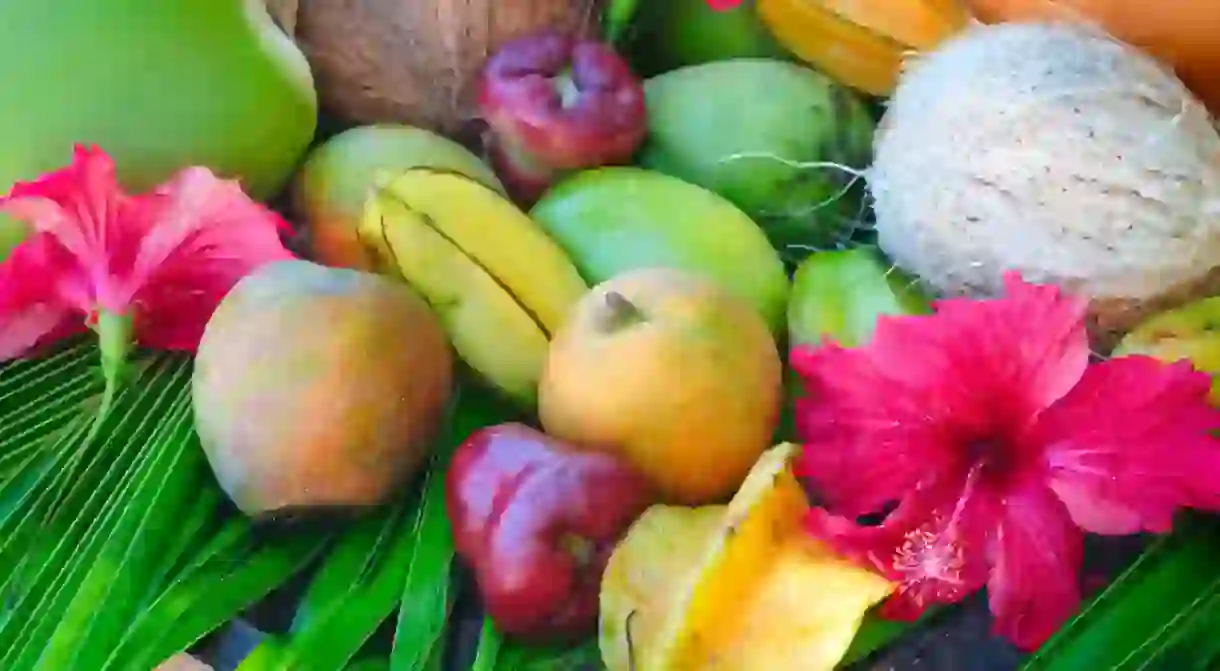10 Fruits and Vegetables to Try from Puerto Rico

One of the greatest things about traveling is all of the fresh fruits and vegetables, many of which may be new to the traveller. Discover the delicious taste of fresh fruit that hasn’t been picked green and “ripened” in a warehouse. Here are a few that you should try when you visit Puerto Rico.
Quenépa
Whether for its curious texture or its rich flavour, this is one of the most requested exotic fruits by Puerto Ricans. According to ‘Women’s Fitness’ magazine, there are some good health benefits from the consumption of quenépas. Boiling the leaves to make tea can help with intestinal problems. It is low in fat, calories, and cholesterol, a natural anti-diabetic, lowers blood pressure and helps with asthma. It is also a sleep aid, helps lower cholesterol and prevents constipation.
Mango
Originating in Asia and India, mangos are cultivated the world over. Mangos are generally sweet although the taste and texture does vary from one genus to another. They are thought to help with skin and hair repair, fight cancer, ease asthma, prevent heart disease, and help some age-related health issues. There is a warning though about mangos. The skin of a mango contains a natural chemical that is the same in poison ivy and poison sumac. People who have severe reactions to these plants need to exercise more caution. Most reactions occur when the eater scrapes the skin with their teeth, thereby getting the oils into their system.

Pineapple
A fruit that is actually many berries that fuse together around a central core, pineapple is a sweet fruit that can be grilled, baked, juiced or eaten raw. Pineapples support eye health, bone health, boosts immune system, aids digestive system, is an anti-inflammatory, assists with blood clot reduction (excellent fruit to eat before flying), reduces inflammation and is a natural cough suppressant. And of course Puerto Rico is the home of the piña colada, so make sure you try one on your visit.

Yautia
First domesticated in South America, this root vegetable is elongated, brown, patchy, and shaggy looking. It is a huge favorite among Cubans and Puerto Ricans alike. It is used in sancocho, sopa de mondongo, pasteles, and alcapurrias. Benefits include brain health, thyroid health, mood enhancement, anemia prevention, blood vessel health, heart and kidney health, also promotes healthy pregnancy and detoxification.

Plantains
Platanos verde can be eaten green or yellow. Yellow is much sweeter and used in stew recipes for example, or to make pastelon, Puerto Rican lasagna. Green plantains are usually fried and used to make tostones, which replace french fries, or to make mofongo. They look like a large banana and the green ones are still hard while the yellow ones are softer. Consuming plantains can help with many digestive disorders as they are full of complex starches unlike potatoes. They are helpful in lowering hypertension and heart disease and can assist the immune system, and they can help lower cholesterol, as long as you do not solely use them for fried treats.
Guanabana
The guanabana, also known as soursop in other areas of the Caribbean, is a large green heart-shaped fruit with small spike-like protrusions. The white flesh is custard-like and sweet. The seeds are toxic and should not be eaten. Guanabana is a super-healthy fruit that is said to fight bacterial and fungal infections, high blood pressure, depression, some nervous disorders, and stress. Some studies have shown that guanabana can assist in fighting cancer.
Starfruit
Commonly known as carambola in Puerto Rico, this five sided waxy fruit grows on a tree after its pretty flowers bloom. It is very juicy and sweet, like a citrusy pear. Benefits include being an anti-cancer food, prevents heart disease, boosts immunity, stimulates lactation in nursing mothers, is an anti-inflammatory, promotes weight loss, lowers cholesterol, aids digestion, and boosts metabolism.
Cassava
A nutty flavored starchy root vegetable, cassava is used in soups or stews, shredded and fried or ground into flour. The main benefit of cassava is its complex starches which aid digestion.
Breadfruit
The ripe fruit is soft, cream colored or yellow, pasty, and has a sweet aroma. It is excellent roasted, baked, boiled or fried. A popular treat when breadfruit are ready are tostones made with pana or panapen (breadfruit),a little lighter and fluffier alternative to those made with green plantains. Rich in amino acids, it prevents and reverses oxidative stress, keeps the heart strong, boosts your immune system, and is said to help prevent certain cancers.
Rose apple
Pomarrosa is said to propagate year-round, but it is somewhat hard to find and when you do you will appreciate the treasure hunt. This delicate fruit is also known as a Puerto Rican Apple or Water Apple. It has a firm white flesh that resembles the texture of a pear, and a very delicate pinkish-red skin. It is tremendously juicy and each bite leaves just the hint of rose flavor on your tongue. As with many fruits, pomarrosa is said to help control diabetes, aids digestion, is said to prevent cancer, boost immunity and leads to better cholesterol levels and heart health.

Check out these tours and excursions in and around Puerto Rico













